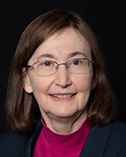
Maureen R. Hanson
Cornell University
|
Primary Section: 25, Plant Biology Secondary Section: 62, Plant, Soil, and Microbial Sciences Membership Type:
Member
(elected 2021)
|
Biosketch
Maureen Hanson is a molecular biologist known for her research on the joint nuclear and organelle control of gene expression in plant mitochondria and chloroplasts. She is recognized for identification of a mitochondrial gene that specifies cytoplasmic male sterility and a nuclear gene that restores fertility. In addition, her lab rediscovered and re-opened analysis of dynamic plastid extensions that she named stromules. She has also made major contributions to the understanding of RNA editing in plant organelles. Hanson grew up in the Washington, D.C. suburbs. She was graduated with a B.S. from Duke University (1971) and a Ph.D. from Harvard University (1976), where she stayed for an NIH Postdoctoral Fellowship. She joined the faculty of the Department of Biology of the University of Virginia in 1979 before moving to Cornell University in 1985, where she is Liberty Hyde Bailey Professor in the Department of Molecular Biology and Genetics. She received the Cornell CALS Award for Excellence in Basic Research and the SUNY Chancellor’s Award for Faculty Service. She is a Fellow and recipient of the Lawrence Bogorad Award for Excellence in Plant Biology from the American Society for Plant Biology. She is a Fellow of the American Association for the Advancement of Science, and a Member of the American Academy of Arts and Sciences and the National Academy of Sciences.
Research Interests
Current research in the Hanson laboratory encompasses both plant biology and biomedical research on a disease known as Myalgic Encephalomyelitis or Chronic Fatigue Syndrome (ME/CFS). In plant biology, we are continuing efforts to understand the molecular mechanism of RNA editing in chloroplasts and mitochondria through further analysis of the composition of the RNA editosome, which is responsible for recognizing the proper C for editing and carrying out the conversion to U. We are also attempting to improve the efficiency of photosynthesis through engineering of the carbon-fixing enzyme Rubisco and synthesis of a microcompartment in chloroplasts based on cyanobacterial carboxysomes. For all of our chloroplast projects, we are taking advantage of the ability to introduce transgenes into the chloroplast genome at locations selected by homologous recombination. We have also implemented CRISPR/Cas9 technology in order to engineer the plant for proper functioning of a new carbon-concentrating mechanism. In ME/CFS research, we are examining immune cell metabolism, cargo of extracellular vesicles, cell-cell signaling, plasma metabolites, and plasma protein content, at baseline and following an exercise challenge. Our efforts are directed to understand the molecular basis of symptom generation and development of a diagnostic test that will permit early identification of disease victims.

